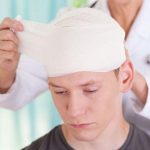When kids suffer a concussion, an extended period of rest at home is always the best course, right? Perhaps not.
In fact, a new study suggests that — despite what many people may presume — getting kids back to school quickly is the best way to boost their chance for a rapid recovery and better outcomes.
The finding stems from a look at post-concussion outcomes of more than 1,600 children between the ages of 5 and 18.
“There has been minimal research to date that provides guidance to clinicians, parents and schools regarding an appropriate time for youth to return to school after a concussion,” said study leader Christopher Vaughan, a pediatric neuropsychologist at Children’s National Hospital in Rockville, Md.
The current guidance, he said, is more general about activities and less specific to returning to schools. Usually, a rest period of 24 to 48 hours is encouraged, with a gradual return to activities, including school, based on symptom tolerance.
“We found that [the] typical time away from school ranged from three to five days, but that an earlier return to school — defined as missing two or fewer days of school, excluding weekends — was associated with a lower symptom burden at two weeks post-injury,” Vaughan said.
For the study, his team focused on the post-concussion experience of 1,630 children who were treated at one of nine pediatric emergency departments across Canada.
The children were part of a previous study that ran from August 2013 to September 2014. During the month after a concussion, the original researchers contacted parents several times to see how their child was doing and track return-to-school patterns.
They focused on the presence of symptoms two weeks after a concussion, including headaches, confusion, forgetfulness, trouble with concentration, orientation and recall, nervousness and/or sadness.
That information was then stacked up against number of school days missed, type and severity of each child’s injury, as well as previous concussions, headaches, anxiety disorders and/or ADHD.
The result: An early return to school was broadly associated with fewer symptoms across all ages.
“The findings were, and were not, surprising,” Vaughan said, adding that the COVID-19 pandemic has shown that kids do better overall with the structure and socialization provided in school.
“In concussion treatment, we know that prolonged rest and inactivity can be harmful,” he said.
Rest seems to be most beneficial in the first day or two after injury, Vaughan said. But when it comes to resuming social, athletic and learning activities, “the sooner that we can safely return someone to normal activities, the better,” he said.
Still, every patient’s experience is different, Vaughan said, and this study isn’t able to say when a specific child with a concussion should return to school. That’s likely to be based on individual factors such as severity of the injury, supports within the school and others specific to individual children.
“What this research does tell us is that there are a number of benefits for youth going back to school as soon as they are able, and that missing more time from school after concussion is not something that we should generally recommend unless it appears to be absolutely necessary for specific reasons,” Vaughan said.
Dr. Daniel Daneshvar is an assistant professor at Harvard Medical School who treats brain injuries at Mass General Brigham in Boston.
He reviewed the findings and offered several reasons why a quick return to school might be helpful, including the increased brain blood flow that can accompany resumption of activities, as well as the social and emotional benefits of hanging out with friends and having fun.
“If you hold kids out from school longer, it may give them the impression that their brain injury is a lot worse,” Daneshvar said. And that can sometimes trigger a kind of reverse-placebo effect, in which that impression alone inadvertently prolongs symptoms.
“Every person’s brain is different, and every brain injury is different,” he said. “There’s really no standard timeline when it comes to recovery from a traumatic brain injury or concussion.”
Nonetheless, this study — together with other recent findings — suggests that the traditional approach is probably not best, Daneshvar said.
“The old idea of waiting for injured kids to be completely symptom-free before advancing their mental and non-contact physical activity is probably too conservative,” Daneshvar said.
“In my practice, we monitor symptoms and increase activity even if symptoms recur, as long as we’re taking extra care to ensure that individuals are not doing anything that could put them at risk of getting another hit to the head until they’re fully recovered,” he said.
The findings were published Jan. 20 in JAMA Network Open.
More information
There’s more on concussion recovery at the U.S. Centers for Disease Control and Prevention.
SOURCES: Christopher Vaughan, PsyD, pediatric neuropsychologist, Children’s National Hospital, Rockville, Md.; Daniel Daneshvar, MD, PhD, assistant professor, Harvard Medical School, and brain injury physician, Mass General Brigham, Boston; JAMA Network Open, Jan. 20, 2022
Copyright © 2025 HealthDay. All rights reserved.



-300x169.jpg)












